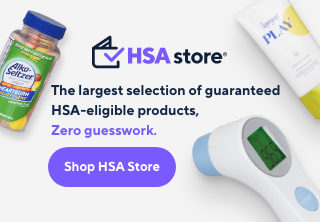How HSAs Work
An HSA lets employees put aside the healthcare money needed for them and their families—tax free—saving 25 to 40% on every dollar.
HSA participants can use funds from their account to pay current out-of-pocket health expenses or keep the money in their account, earning interest until they need it in the future. It’s a great benefit and employees’ accounts stay with them ... through changing jobs to retirement.
A Health Savings Account is Money in the Bank
An HSA is a personal bank account that belongs to the employee. It is used in combination with an eligible High Deductible Health Plan (HDHP). To open an account, the employee must complete their company’s benefit enrollment and bank application processes, including acceptance of the bank terms and conditions. Their account must be open before they can deposit or access money.
Remember, like any other bank account, HSAs may be overdrawn. Bank-specific policies, rules and information apply so make sure that employees read the information received about their account from the bank.
Current Contribution Limits
The IRS sets the amounts that employees contribute to an HSA each year. The limits include contributions from any source, so if employers are also contributing to HSAs, those amounts must be included in the total.
2024 Maximum Contribution Amount
Individual: $4,150
Family: $8,300
Catch-up (age 55+): $1,000
2025 Maximum Contribution Amount
Individual: $4,300
Family: $8,550
Catch-up (age 55+): $1,000
Change Savings Amounts
Employees tell their employer when they want to change the tax-free amount set aside each paycheck. As long as they do not go over the federal-set annual limits, employees can save as much as they want.
Invest HSA Savings for Long-Term Gain
Once employees have achieved a certain balance they may choose from a variety of investments to maximize their savings over time. Check with the bank to confirm the minimum balance required and the investments offered.
A Health Savings Brokerage Account (HSBA) is a self-directed individual brokerage account designed to complement a Health Savings Account. The HSBA provides Chard Snyder HSA plan participants access to thousands of investment choices. Employers can also benefit, as offering an HSBA with your benefits package can be an effective aid in attracting and retaining top talent. Learn more about investing HSA funds
No Claims to File
Employees never file a claim to be reimbursed for expenses from their HSA. They pay their provider or reimburse themselves for eligible expenses with their HSA benefits card or check. Employees only spend up to the current balance in their accounts.
Keep Good Records and Save Your Receipts
The IRS may require employees to prove that all money taken from their HSA was used for eligible expenses, so keep the explanation of benefits, bill or receipt as proof with tax information for seven years. A cancelled check or benefits card receipt cannot be used as proof of eligible expenses.
Eligible Expenses
Employees may use their HSA for any IRS-approved health, dental and vision expenses, and for insurance premiums -- COBRA premiums, premiums while they are receiving unemployment compensation, retiree-health premiums, Medicare Part D premiums, and long-term care premiums.
See the list of Health Savings Account Eligible Expenses
